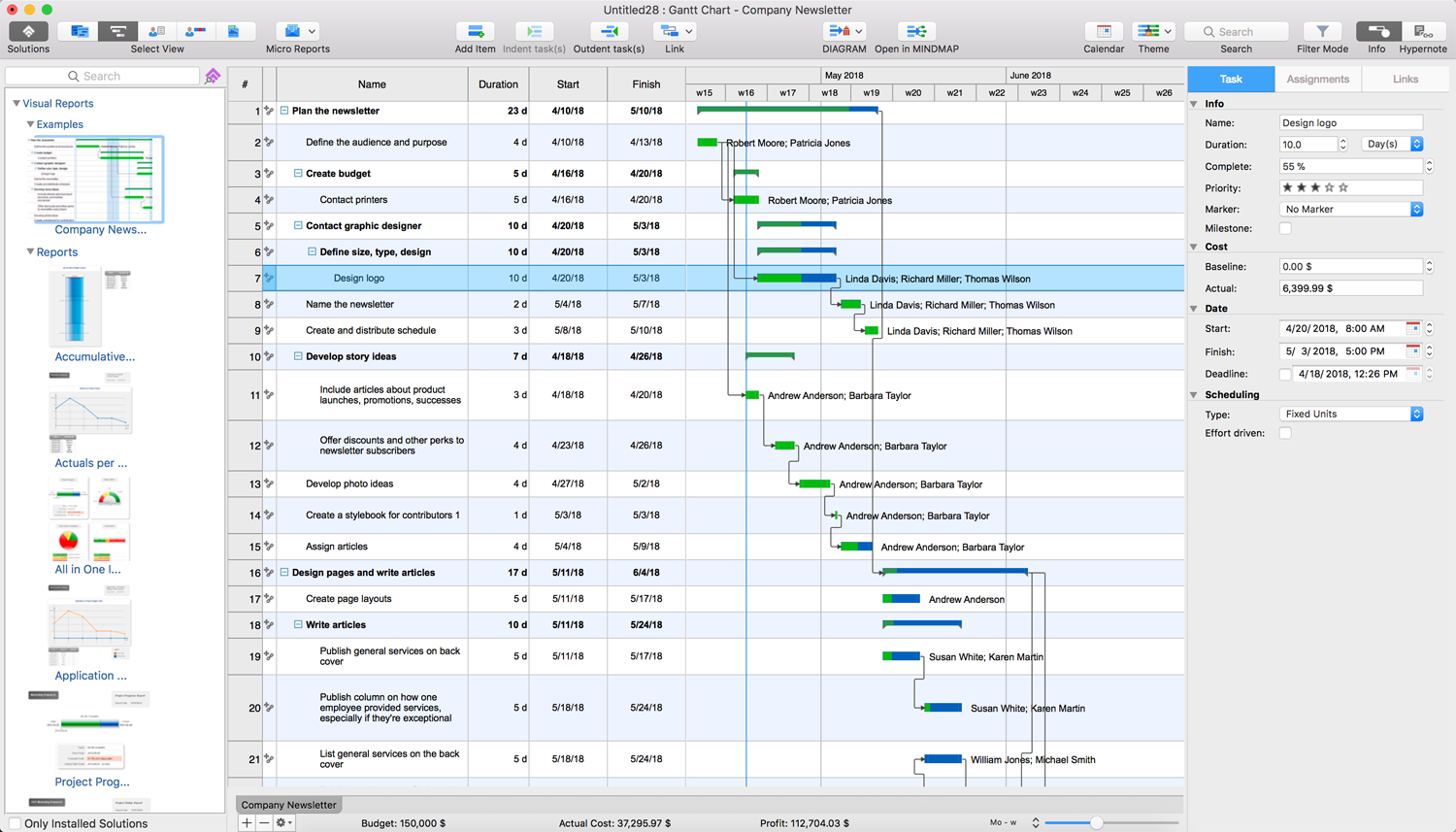Creative Project Management Software
Notice: Undefined offset: 0 in /var/www/html/conceptdraw/project-management/template.php on line 447
Looking for a creative project management software, the ConceptDraw PROJECT application might become a useful tool once it is downloaded from this site. Managing the multiple projects for one single place such as the ConceptDraw PROJECT project management software is easy as there are many advantages of using it.
Viewing the resource assignments to all tasks in all ongoing projects and identifying the resource overload areas on time has become possible thanks to the ConceptDraw PROJECT application — the creative project management software developed by the team of specialists of CS Odessa. Having many specialists involved in projects can never stop the project manager who uses the ConceptDraw PROJECT to monitor their work on tasks as well as adjusting it from a single view when it’s needed.
Once downloaded, the ConceptDraw PROJECT software may become a useful assistant in managing project changes quickly using the traditional tabular project reports. Also, the reporting mind maps and project dashboards can be used when needed. Project Dashboard is the one that can consolidate all the current information onto one screen, allowing you to have a powerful visual view of projects and enabling you to monitor and so to share the project statuses on time.

Notice: Undefined variable: patterns in /var/www/html/conceptdraw/project-management/template.php on line 504
Warning: Invalid argument supplied for foreach() in /var/www/html/conceptdraw/project-management/template.php on line 504
Pic 1. Creative Project Management Software
Knowing basics of project management may not be always enough as once there is some problem that appears then sometimes it can be solved as long as there is enough experience the project manager has. Nevertheless, in this article, we can show the diversity of the project management techniques, such as Business Change Analysis and Cost-Benefit Analysis so you can learn more about the commonly used tools apart from the already mentioned creative project management software.
First, the Business Change Analysis. It is a well-known technique used to integrate all the ongoing change activities into a total business sequence change program. All aspects of managerial, social, technological and operational change must be driven by the needs of the enterprise. And all changes can be prioritized for proper sequencing once they are identified in order to maximize the benefit stream constraints.
In order to conduct the Business Change Analysis, the change and action item information needs to be collected. Identifying additional changes and impacts is also very important. Once the resources are confirmed, then the change initiatives may be prioritized. Determining the sequence of business changes would be the next step. And once the recommendations are received, the detailed transition plans may be developed.
A few activities during a re-engineering project are required in order to implement the needed re-engineering solutions. Social system requirements definition is the one that creates the specialized change activities for effecting all the change by using organizational readiness assessment techniques. Technological impacts may be determined by using numerous techniques, including Systems Component Mapping, Current Systems Analysis, Information Architecture Impact Analysis, etc.
You can always review all of the available information, summarizing it by using a so-called “business change analysis summary worksheet”. Identifying the potential benefit stream as well as any needed constraints and additional actions is required, same as summarizing the results. identify target sequences of change for each of the change initiatives. Next, determine all the change dependencies as well as the associated risks. Re-sequence the changes that were driven by the mentioned business considerations. Draft a preliminary timeline for the changes that are based on determining the resources — both available and required ones.
Using a formal payback schema may be possible while conducting the Cost-Benefit Analysis that can be sometimes also called as benefit costs analysis. This systematic approach may be used for estimating the strengths and weaknesses of alternatives, such as in transactions, functional business requirements, projects investments and activities, being used for determining the options that provide the best approach in order to achieve the benefits while preserving savings.
The Cost-Benefit Analysis can be also defined as a systematic process for comparing and calculating benefits and costs of a policy, project or decision. In project management it is widely used, being known for having two main purposes. The first aim is to determine whether a decision is sound. It can be done by verifying whether its benefits outweigh the costs, for example. The second one is to provide a basis for comparing projects. Such basis may involve comparing the total expected cost of each of the options against all the total benefits that are expected to appear.
The Cost-Benefit Analysis is known to be related to the cost-effectiveness analysis. Thus, both costs and benefits may be expressed in monetary terms, being adjusted for the time value of money. In this case, all flows of benefits, as well as flows of project costs appearing over time, may be expressed on a common basis in terms of their net present value.
Many formal techniques include cost-effectiveness analysis, same as cost–utility analysis, social return on investment analysis, economic impact analysis, risk–benefit analysis and fiscal impact analysis. Not all project managers know all the project management techniques but once they have the appropriate tool such as ConceptDraw PROJECT one for taking part in running the company’s business, then they might succeed.
ConceptDraw PROJECT software allows:
- Managing project changes quickly by using either tabular project reports, reporting mind maps or project dashboards,
- Using the Project Dashboard that consolidates all the current information onto one screen,
- Getting an access to a powerful visual view of projects that enables its users to share and monitor project status instantly,
- Managing resources over multiple projects from a single place, etc.